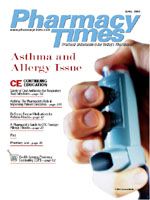Publication
Article
Pharmacy Times
A Pharmacist's Guide to OTC Therapy: Allergic Rhinitis
Author(s):
Every year, >$1 billion is spent on medications to treat allergic rhinitis (AR),1 a disease that affects >20% of the population. 1 Although AR is not life-threatening, complications may occur that can impact quality of life. Pharmacists can play a key role in helping patients find symptomatic relief from this condition (Table).
Systemic Antihistamines
Systemic antihistamines are not optimally effective because many other inflammatory cytokines (besides histamine) are released. For best results, antihistamines must be used before symptoms are expected to occur in order to block the histamine1 receptor (~1-2 weeks before the allergy season begins).1
Antihistamines should be avoided in patients with cardiovascular disease, benign prostatic hypertrophy (BPH), and asthma. They also should be avoided in patients taking monoamine oxidase inhibitors (MAOIs) or tricyclic antidepressants. In patients who are pregnant or breast-feeding, chlorpheniramine (Chlor-Trimeton), tripelennamine (PBZ), or loratadine (Claritin) may be used only if an initial trial with nasal cromones results in treatment failure.2
The most common side effects of antihistamines are dry mucous membranes, blurred vision, and urinary retention. In addition, whereas children and the elderly may experience paradoxical excitation with first-generation antihistamines, sedation is the most common side effect. Therefore, first-generation antihistamines usually are avoided in the treatment of AR. When they are used, however, drinking alcohol and operating heavy machinery should be avoided. Triprolidine can vary between producing slight drowsiness to deep sleep, but it is available only in combination with the decongestant pseudoephedrine (Actifed). Because of the decongestant, Actifed should be avoided in patients with hypertension or narrow- angle glaucoma.
Decongestants
Decongestants are alpha-adrenergic agonists. Systemic agents work best, but they should be avoided in patients with hypertension, diabetes, arrhythmias, glaucoma, BPH, and hyperthyroidism because of their effects on glucose and vasoconstriction. Pregnant and breast-feeding patients, along with those taking MAOIs, also should avoid decongestants. The only OTC oral, systemic decongestant that is available in the United States is pseudoephedrine (Sudafed).
Of the locally effective products, the 8-to 10-hour nasal spray xylometazoline (Otrivin) and the 12-to 24-hour spray oxymetazoline (Afrin) are favored because they provide longer relief than the shorter-acting nasal decongestants. Decongestant eyedrops include oxymetazoline (Visine LR), naphazoline (Clear Eyes), and tetrahydrozoline (Visine). The use of these ocular medications is solely cosmetic because they only remove eye redness.
Nasal Cromones
Cromolyn (NasalCrom) is an antiinflammatory agent. It is not as effective as prescription nasal corticosteroids, however. In fact, it takes 1 to 2 weeks of scheduled use to see its effect.2 Common side effects include temporary burning and stinging. Nasal cromones are the drugs of choice for AR in pregnant patients.2 As with all nasal inhalers, the nasal cromolyn inhaler should be cleaned after each administration, and it must be discarded in 2 to 3 months regardless of the manufacturer's expiration date in order to prevent drug contamination.1
Dr. Umland is an associate professor of clinical pharmacy at the University of the Sciences in Philadelphia, Pa, and an adjunct clinical assistant professor of family medicine at Jefferson Medical College, Thomas Jefferson University. Ms. Thomas is a PharmD candidate at the University of the Sciences.
For a list of references, send a stamped, self-addressed envelope to: References Department, Attn. A. Stahl, Pharmacy Times, 241 Forsgate Drive, Jamesburg, NJ 08831; or send an e-mail request to: [email protected].







